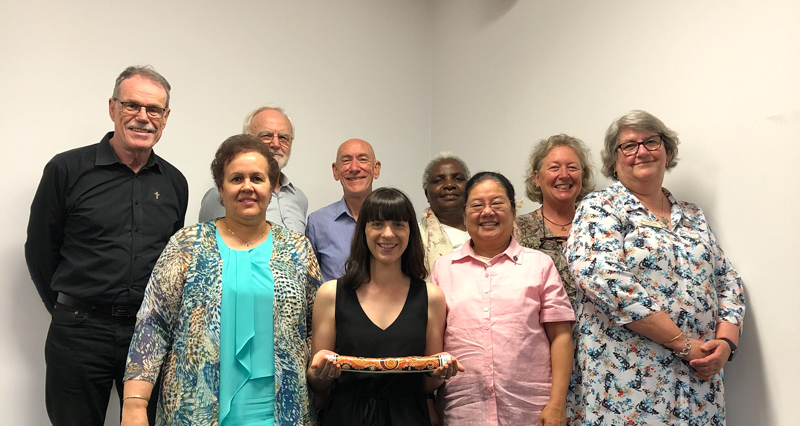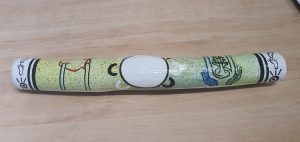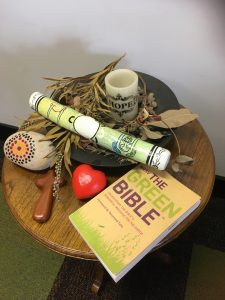
JEDO MESSAGE STICK – SYMBOLS and INFORMATION
1 – All Noongar Protocols have been adhered to. (Being a Yamitj woman I have asked for permission to paint in Noongar Country. And I source the wood from Yuet Country and have asked for permission to use wood from Yuet Country. Permission has been granted on both occasions.)
2 – Symbols used to depict the Story/Message on the Message Stick.
Bands on each end – To remind us that everything in life has a Beginning and an End.
FRONT
3 – Concentric Circles (white and black) – symbolises being on Country. It is a place of great importance – where everyone is valued and have an equal voice. This is where we sit, look, listen and learn from each other with great respect.
4 – White circle in the Centre – Eucharist, celebration of our Christ-centred identity.
5 Feet – Walking together in the Spirit of true reconciliation
6 – JEDO Logo (deconstructed) – self explanatory

BACK
7 – Wave background symbolic of – Waagle, honouring the Ancient Aboriginal creation story
8 – Dots on the Wave symbol are purely decorative – in this instance
9 – Concentric circles off balance – a reminder to care for Country
10 – Aboriginal symbols on either side of wave symbol – confirming that our Creation Spirit/God has given us everything we need to live to sustain us. Food, Shelter, Tools, Water, Fire, People etc.
NOTE
White ends and markings symbolise – Peace, Hope and Harmony.

The History of Message Sticks
The Australian Aboriginal Peoples are considered to be the most ancient people on Earth. They are the oldest continuous living culture on Earth with estimates of their cultural existence varying between 60,000 and 75,000 years. Aboriginal Message Sticks are therefore a custom that dates back over 60,000 years.
They were a means of communicating between different Aboriginal tribes, and a “messenger” transported the sticks by hand (travelling on foot). The messenger—the one who carried the message stick was traditionally granted safe and protected entry to other nation’s territory—a sort of visa or passport. The messenger would then convey the message to the elders of the tribe meant to receive the message. Sometimes tribes would add to the message as the messenger passed though.
The messages inscribed on the stick (by painting, carving, burning, etc.) were primarily “prompts” for the messenger so that the message would be conveyed consistently to each different nation’s elders. Typical messages would be announcements of ceremonies, disputes, invitations, warnings, meetings, events and happenings.
MESSAGE STICK WOOD
Eucalyptus wandoo, commonly known as wandoo, dooto, warrnt or wornt,[2] is a small to medium-sized tree that is endemic to the southwest of Western Australia. It has smooth bark, lance-shaped adult leaves, flower buds in groups of nine to seventeen, white flowers and conical to cylindrical fruit. It is one of a number of similar Eucalyptus species known as wandoo.
Eucalyptus wandoo was first described in 1934 by William Faris Blakely in his book: A Key to the Eucalypts.[6] The specific epithet “wandoo” comes from the Noongar name for the tree. [3]
Wandoo Message Stick Wood
NOTE: The Wandoo wood is a heavy and strong wood – It is symbolic to me of Strong Bonds.
The wood is intentionally sourced from Yuet Country.
Mogumber Native Reserve is on Yuet Country.
My father is one of the Stolen Generation/s and was incarcerated at the age of 7 years old.
I want the wood to be a reminder of the Stolen Generation/s. To remember those who died and those who survived their incarceration. We need to work together to ensure that this dark past is never repeated, through education, as a Christian and in the spirit of true reconciliation…..together!
Cheryl Lennox-Bradley
DON’T WALK IN FRONT OF ME – I MAY NOT FOLLOW
DON’T WALK BEHIND ME – I MAY NOT LEAD
JUST WALK BESIDE ME AND BE MY FRIENDS

